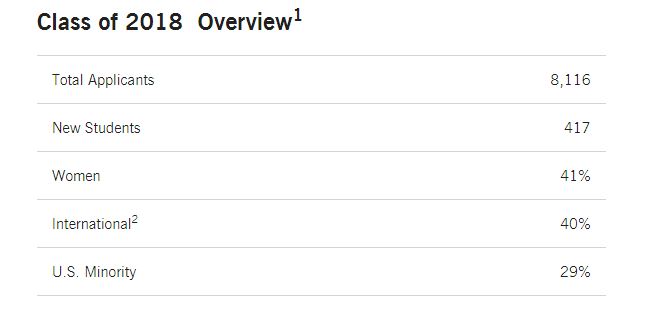Always one of the last schools to publish its class profile, Stanford Graduate School of Business (GSB) yesterday shared details about the Class of 2018, revealing a significantly rebounded average GMAT score and growing diversity. As the final class to be hand-selected by Derrick Bolton—the school’s longstanding admissions director who earlier this month left his role to head admissions for Stanford’s new Knight-Hennessy Program—it’s something of a crowing achievement.

Record Application Volume, Record U.S. Minority Enrollment
The school received a record number of applicants for the 2018 class. In total, Stanford accepted 417 students in the 2018 MBA program out of a pool of 8,116 applicants—up from 7,899 last year. The school reports an acceptance rate of 6 percent, down a tenth of a percentage from last year’s 6.1 percent and almost a full percentage point from two years ago. In other words, the most selective school in the world has grown even harder to get into. For comparison, Harvard Business School (HBS) this year accepted 11 percent of its applicant pool. Stanford’s yield this year—the percentage of admitted applicants who opt to enroll, was 88 percent, just shy of HBS’s industry-leading 90 percent.
These strong showings are particularly noteworthy given that the school faced a torrent of unfortunate press this past year relating to a scandal involving its former dean. Bolton’s boss, Stanford GSB Senior Associate Dean for Academic Affairs Madhav Rajan, conceded in an August interview with Clear Admit that perception had been issue in this latest admissions cycle. But at the time of that interview, Rajan already knew that the GSB had received a record-setting number of applications and that yields looked very strong. “That’s all credit to Derrick and his team keeping their heads down and doing their jobs in a difficult situation,” he said.

The resulting class represents 62 countries, more than any other previous Stanford GSB class. Nearly 41 percent of the class identified as female, a slight uptick from 40 percent last year. International students remained flat, at 40 percent, but U.S. minority students represented the most notable increase, shooting up to a record-high 29 percent, compared to 19 percent last year.
Average GMAT Score Soars, Range Narrows
The average GMAT score was 737, up 4 points from last year, though still shy of 2011’s record 739. While not an unprecedented high for the school, it still makes Stanford the clear front runner among all leading business schools that have thus far shared class profile information this year. (The closest are the University of Pennsylvania’s Wharton School, with a 730 average, and HBS, with a 730 median.) The rise in average GMAT score at the GSB reflects a narrowing of the overall score range. This year, scores fell between 590 and 790, compared to last year’s range of 570 to 800.
International students accepted into the program maintained an average TOEFL score of 112 with an overall range of between 104 and 119. The average GPA of the group slipped slightly, to 3.73 from last year’s 3.75.
Greater Diversity in Undergrad Focus, Work Experience
 The slip in GPA comes against a backdrop of growing diversity both in terms of students’ undergraduate focus and their work experience. Of this year’s incoming class, 48 percent studied the humanities and social sciences as undergrads, followed by 37 percent who studied engineering/mathematics/natural sciences and 15 percent who studied business. Approximately 11 percent of the class has already earned another advanced degree.
The slip in GPA comes against a backdrop of growing diversity both in terms of students’ undergraduate focus and their work experience. Of this year’s incoming class, 48 percent studied the humanities and social sciences as undergrads, followed by 37 percent who studied engineering/mathematics/natural sciences and 15 percent who studied business. Approximately 11 percent of the class has already earned another advanced degree.
These 417 students entered the program with a wide range of work experience, with some as high as 13 years prior to entry. On average, the class maintained four years of professional work experience upon acceptance, as has been true of the last several incoming classes.
This year’s first-year students also come to Stanford from a staggering 312 different organizations, with the greatest percentages from investment management/private equity/venture capital (20 percent) and consulting (18 percent). Technology was a close third, with 16 percent coming from this growing sector.
Kudos to Bolton on his final Stanford GSB class. Margaret Hayes is heading MBA admissions at Stanford on an interim basis—in addition to maintaining her role as assistant dean of the MBA program, responsible for overall administration of the MBA program—until a replacement for Bolton is found.





